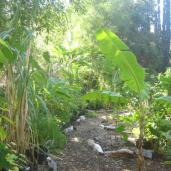When I first read Bill Mollison’s definition of “order”, from his Permaculture Manual, I had to put the book down and walk around the room for a while, and then go outside and walk some more. This one small paragraph changed my life and changed the way I view everything around me. It opened up horizons that I am still exploring, and will explore for the rest of my days. Here is my paraphrase of this devastating definition:
ORDER: An orderly system is a system that produces, or yields, more than it consumes.
Now, consider that there are gradients to this. One can outright steal something and give nothing in return, or one can produce less than what he was paid to do. One could use resources that he doesn’t pay for, or create waste or toxins that he doesn’t take responsibility for, leaving it up to someone else to pay the bill – these are examples of consuming more than one produces and all of them are criminal. These are more common than one may think in this country. A society made up of people who do this will soon fail. If one gives a fair exchange for what he is paid, that is honest, but the most ideal and desirable system of production allows one to give more than he receives. That is a system that produces in abundance.
Permaculture is the science of studying, designing and controlling energy flows and structure that facilitates “producing in abundance” whether in natural systems and other types of systems (including economic, business, production, and community systems).
This one definition unlocked for me how that could happen. All of a sudden, I started looking at neatly manicured grass lawns as inapplicable swaths of grossly disordered systems. They steal huge amounts of resources – water, fertilizer, sunlight, money and human labor, giving very little energy back to the system from which they derive their sustenance in the process.
Neat rows of corn are another example of anti-order – not only do they use far more resources than what they provide in return, but they leave the fields worse off than they were, with depleted soils and destroyed diversity. They even destroy other ecosystems, such as the nearly 8,000 square mile dead zone in the Gulf of Mexico - http://www.washingtonpost.com/wp-dyn/content/story/2008/07/31/ST2008073100349.html?hpid=topnews - created by fertilizer run off from corn and soybean fields that travels down the Mississippi River.
“How can that be?” you say. “How can corn fields use more resources than they provide and still be profitable? That makes no sense.” Well, you’re right, it does not make any sense. The entire supportive system would have to be massively skewed to create such an illusion, and it is. Massive government subsidies to agriculture and energy industries make wildly inefficient farming methods profitable. As well, if one measures only money as an exchange value, and does not measure the actual energy exchange, then one can miss the real picture of order versus disorder. One exercise given to students of sustainable design is to trace down the “life cycle” of a product – ie. Document all the energy and resources that are used in the creation of that product. For corn, that might include the GMO seeds, the petroleum products used to fertilize and kill weeds and bugs, the machinery, the processing of the corn product, the shipping costs, the packaging, and cost of selling the product. An examination of alternative systems, like a number of intensive, organic farming methods, will show reduced and less expensive energy and resource needs at every one of these production points. Without subsidies and a skewed system, these methods would be far more profitable. It is simple logic.
Farming methods in the Midwest are destroying the livelihood of shrimp fishermen in the Gulf by killing off the shrimp with pesticide and fertilizer run off. They do not have to pay the costs borne by those fishermen. And depleted soils and water supplies created by modern industrial farming are debts that will need to be confronted and paid by our children and grandchildren. Those are hidden costs that don’t show up on the bottom line of Archer Daniels Midland. Someone else is paying or will pay in the future, so that corn production can show a black bottom line now. This is not “free market” or “good business,” it is simply criminal.
So, why do we operate this way? Can our ivy league accountants and MBA’s really not add and subtract true costs? Do they know what the costs of doing business actually are, but they just really don’t believe they can pay real costs and still make a profit? If so, where did these ideas come from?
How can one avoid criminality and still make a profit? And how did we get in a position where we have to ask ourselves that question?
And if neat rows of corn and beautiful green lawns are anti-orderly, what is an example of order?
We will document a number of the best of the best practices and solutions in this blog. Stay tuned for some entertaining, outrageous and perhaps quite surprising viewpoints and information. If you are like me before I was exposed to these concepts, you may experience some life changing paradigm shifts while reading.
There is a lot of exciting, good news to be shared. It is not only possible to live ethically, but one can experience far more abundance and quality of life by doing so. That makes sense, doesn’t it? Come back and visit, for stories and tales of people who are doing it in marvelous ways.




No comments:
Post a Comment